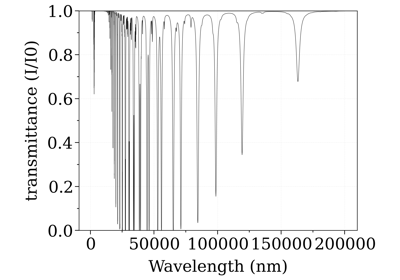radis.los.slabs module¶
Summary¶
Classes to deal with multi-slabs configurations:
MergeSlabs()for several species at the same spatial positionSerialSlabs()to add several spectra along the line-of-path
One Slab is just a Spectrum object
.. rubric:: Examples
See more examples in the RADIS line-of-sight module ——————————————————————————-
- MergeSlabs(*slabs, **kwargs) Spectrum[source]¶
Combines several slabs into one. Useful to calculate multi-gas slabs. Linear absorption coefficient is calculated as the sum of all linear absorption coefficients, and the RTE is recalculated to get the total radiance. You can also simply use:
s1//s2
Merged spectrum
1+2is calculated with Eqn (4.3) of the [RADIS-2018] article, generalized to N slabs :\[ \begin{align}\begin{aligned}j_{\lambda, 1+2} = j_{\lambda, 1} + j_{\lambda, 2}\\k_{\lambda, 1+2} = k_{\lambda, 1} + k_{\lambda, 2}\end{aligned}\end{align} \]where
\[j_{\lambda}, k_{\lambda}\]are the emission coefficient and absorption coefficient of the two slabs
1and2. Emission and absorption coefficients are calculated if not given in the initial slabs (if possible).- Parameters
slabs (list of Spectra, each representing a slab) –
path_lengthmust be given in Spectrum conditions, and equal for all spectra.line-of-sight:
slabs [0] \==== light [1] -> )=== observer [n] /====
- Other Parameters
kwargs input
resample (
'never','intersect','full') – what to do when spectra have different wavespaces:If
'never', raises an errorIf
'intersect', uses the intersection of all ranges, and resample spectra on the most resolved wavespace.If
'full', uses the overlap of all ranges, resample spectra on the most resolved wavespace, and fill missing data with 0 emission and 0 absorption
Default
'never'out (
'transparent','nan','error') – what to do if resampling is out of bounds:'transparent': fills with transparent medium.'nan': fills with nan.'error': raises an error.
Default
'nan'optically_thin (boolean) – if
True, merge slabs in optically thin mode. DefaultFalseverbose (boolean) – if
True, print messages and warnings. DefaultFalsemodify_inputs (False) – if
True, slabs are modified directly when they are resampled. This avoids making a copy so is slightly faster. DefaultFalse.
- Returns
Spectrum – observed at the output. Conditions and units are transported too, unless there is a mismatch then conditions are dropped (and units mismatch raises an error because it doesnt make sense)
- Return type
object representing total emission and total transmittance as
Examples
Merge two spectra calculated with different species (physically correct only if broadening coefficients dont change much):
from radis import calc_spectrum, MergeSlabs s1 = calc_spectrum(...) s2 = calc_spectrum(...) s3 = MergeSlabs(s1, s2)
The last line is equivalent to:
s3 = s1//s2
Load a spectrum precalculated on several partial spectral ranges, for a same molecule (i.e, partial spectra are optically thin on the rest of the spectral range):
from radis import load_spec, MergeSlabs spectra = [] for f in ['spec1.spec', 'spec2.spec', ...]: spectra.append(load_spec(f)) s = MergeSlabs(*spectra, resample='full', out='transparent') s.update() # Generate missing spectral quantities s.plot()
- SerialSlabs(*slabs: Spectrum, **kwargs: dict) Spectrum[source]¶
Adds several slabs along the line-of-sight. If adding two slabs only, you can also use:
s1>s2
Serial spectrum
1>2is calculated with Eqn (4.2) of the [RADIS-2018] article, generalized to N slabs :\[ \begin{align}\begin{aligned}I_{\lambda, 1>2} = I_{\lambda, 1} \tau_{\lambda, 2} + I_{\lambda, 2}\\\tau_{\lambda, 1+2} = \tau_{\lambda, 1} \cdot \tau_{\lambda, 2}\end{aligned}\end{align} \]where
\[I_{\lambda}, \tau_{\lambda}\]are the radiance and transmittance of the two slabs
1and2. Radiance and transmittance are calculated if not given in the initial slabs (if possible).- Parameters
slabs (list of Spectra, each representing a slab) –
line-of-sight:
slabs [0] [1] ............... [n] : : : \==== light * -> * -> * -> )=== observer /====
resample_wavespace (
'never','intersect','full') – what to do when spectra have different wavespaces:If
'never', raises an errorIf
'intersect', uses the intersection of all ranges, and resample spectra on the most resolved wavespace.If
'full’, uses the overlap of all ranges, resample spectra on the most resolved wavespace, and fill missing data with 0 emission and 0 absorption
Default
'never'out (
'transparent','nan','error') – what to do if resampling is out of bounds:'transparent': fills with transparent medium.'nan': fills with nan.'error': raises an error.
Default
'nan'
- Other Parameters
verbose (bool) – if
True, more blabla. DefaultFalsemodify_inputs (False) – if
True, slabs wavelengths/wavenumbers are modified directly when they are resampled. This avoids making a copy so it is slightly faster. DefaultFalse.Note
for large number of slabs (in radiative transfer calculations) you surely want to use this option !
- Returns
Spectrum – observed at the output (slab[n+1]). Conditions and units are transported too, unless there is a mismatch then conditions are dropped (and units mismatch raises an error because it doesnt make sense)
- Return type
object representing total emission and total transmittance as
Examples
Add s1 and s2 along the line of sight: s1 –> s2:
s1 = calc_spectrum(...) s2 = calc_spectrum(...) s3 = SerialSlabs(s1, s2)
The last line is equivalent to:
s3 = s1>s2
- resample_slabs(waveunit, resample_wavespace, out_of_bounds='nan', modify_inputs=False, copy_lines=False, *slabs)[source]¶
Resample slabs on the same wavespace: if the range are differents, depending on the mode we may fill with optically thin media, or raise an error
- Parameters
waveunit (
'nm','cm-1') – which wavespace we’re working inresample_wavespace (‘never’, ‘intersect’, ‘full’) – what to do when spectra have different wavespaces:
If ‘never’, raises an error
If ‘intersect’, uses the intersection of all ranges, and resample spectra on the most resolved wavespace.
If ‘full’, uses the overlap of all ranges, resample spectra on the most resolved wavespace, and fill missing data with 0 emission and 0 absorption
Default ‘never’
out_of_bounds (‘transparent’, ‘nan’, ‘error’) – what to do if resampling is out of bounds:
‘transparent’: fills with transparent medium.
‘nan’: fills with nan.
‘error’: raises an error.
Default
'nan'*slabs (list of Spectrum objects)
- Other Parameters
modify_inputs (False) – if
True, slabs are modified directly when they are resampled. This avoids making a copy so is slightly faster. DefaultFalse.- Returns
slabs – resampled copies of inputs Spectra. All now have the same wavespace
- Return type
list of Spectrum objects




